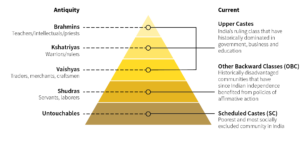Organizational culture diversity has surpassed the idea of being an extra step in forming a business, it is now increasingly clear that it is crucial for an organization to include a diverse workforce for maximum positive growth in the company. The article “Workforce diversity and organizational performance: a study of IT industry in India” written by Subhash Kundu and Archana Mor elaborate on the findings from the study created on the perception of diversity inclusion in the Information Technology industry in India. The study focused on gender, race/ethnicity, caste, and disability minorities and how individuals reacted to companies conscious diversity inclusion tactics. The author’s focus is in the analysis of the diversity and imbalance and researching the underlying issues within the systemic inequality. Their goal was to continue pushing forward for diversity in the workplace by addressing the issues that are taking place with the current status of the conscious inclusion. The two authors aim to inform the reader that the steps being taken for equality are still facing contrasting mindsets against the tactics in place. India was chosen for the study because of its large population that is made of many groups and subgroups of minorities. It is an extremely diverse country with 1.38 billion people who all fall into the social pyramid. Religious and societal classes segregate India, and the complex caste system creates a wide variety of minorities. How each subgroup interprets the forced diversity effects creates the diversity outcome, so it is vital to approach the conscious addition of diversity with a mindset that adheres to the wide variety of individual perceptions.
The IT industry in India has created huge economic growth for the country, it has placed India in a top position of the global IT industry and has raised the GDP from 1.2 percent to 9.5 percent from 1998 to 2014. Although studies show there is an extreme difference between the countries diversity and the IT industry’s. the data recorded showed that of the 114 employees 90% of them were a part of the general category in the caste system and the remaining 10% was made up of Other Backward castes, and the ST’s and SC’s percentages were null. In a related study of 132 employees from eight IT companies 93% were Hindu while the remaining 7% made up the rest of the major religions in India. These percentages do not align with the proportions of the country, thus proving the homogeneity taking place in the industry.
The article addresses many studies that have been done on Indias IT industry’s diversity, as well as their own study they conducted. What differed was the interpretation of the diversity findings. Many of the studies they referred to were based on the statistical data they collected on the minority groups that made up the study populations, while the author’s study was based on the receptiveness of diversity of each subgroup. Their findings show that the separate minority groups tend to perceive diversity in relatively the same views. The greatest difference was found where men were the least receptive to diversifying, and women were much more supportive. The study also helped create a deeper analysis of diversity in organizations, and they discovered that the hierarchical position of an employee has a significant impact on their receptivity of diversity along with the social class they belong to. Even though most countries don’t have a defined social class system there are still physical and monetary boundaries that separate every country, city, and town. To understand how and why a person’s current position in life affects their perspective on diversity in crucial because with our global population in the billions, there isn’t a standard life that stays consistent for most people across the world anymore; The more complex the world becomes, the farther away we drift from a world that is shared equally.
Article
Photo citation
Reuters Graphics. “Caste Politics.” Reuters, fingfx.thomsonreuters.com/gfx/rngs/INDIA-ELECTION/010031Y54EE/index.html.
